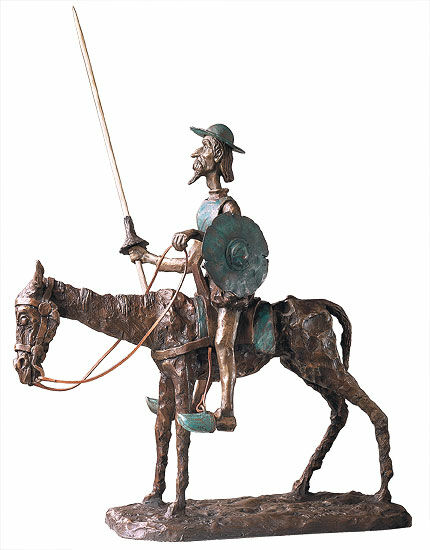Sculpture "Don Quixote, the Knight of the Woeful Countenance", bronze
Sculpture "Don Quixote, the Knight of the Woeful Countenance", bronze
Quick info
ars mundi Exclusive Edition | limited, 199 copies | numbered | signed | bronze | handmade | patinated and polished | size 42 x 45 x 16 cm (w/h/d) | lance length 47 cm
Video
Detailed description
Sculpture "Don Quixote, the Knight of the Woeful Countenance", bronze
Don Quixote, the protagonist from the national epic by Miguel de Cervantes (1547-1616), is still the greatest Spanish hero of all times: With pride, honour and passion, he leaves his everyday life behind and uses his imagination to immerse himself in a world full of adventure. Without further ado, he digs out an old rusty suit of armour appoints his old horse as the warhorse Rosinante and himself as a knight. Only his loyal servant Sancho Panza remains steadfastly faithful to him...
Now RobiN has created another masterpiece from the series "Fairy Tales, Myths and Legends": His sculpture "Don Quixote" is a true work of art full of expression and passion, the culmination of his artistic work to date.
Sculpture made of bronze, cast by hand using the Lost-Wax-Process, partly patinated green, partly polished by hand. With leather straps as reins and a wooden lance. ars mundi Exclusive Edition in a limited edition of 199 copies, numbered and signed. Size 42 x 45 x 16 cm (w/h/d), lance length 47 cm.
Customer reviews
promte Lieferung, bestmögliche Verpackung, sehr schöne Ausführung der Skulptur!
Es handelt sich um eine limitierte Edition. Ich hätte erwartet, zu erfahren, welche
"Nummer" mein Objekt hat!
About RobiN
The artist, born in Munich in 1948, felt no urge to study nude drawing for years at an art academy. He preferred to take his path of art into his own hands. This path led to free art following a preoccupation with philosophical questions. Within a short time, he found his style. Bright colours and free abstract form inventions are as much a part of it as mischievous references to the real world of objects. He implements his ideas and visions with great artistic skill, whether in painting or sculpture.
The breakthrough for RobiN came very quickly. His works can now be seen in many galleries and museums around the world, including the Museum of Tolerance of the Simon Wiesenthal Center in Los Angeles, where he is the first German of non-Jewish faith to be represented.
An alloy of copper with other metals (especially with tin) used since ancient times.
When casting bronze, the artist usually applies the lost-wax technique which is dating back more than 5000 years. It's the best, but also the most complex method of producing sculptures.
First, the artist forms a model of his sculpture. It is embedded in a liquid silicone rubber mass. Once the material has solidified, the model is cut out. The liquid wax is poured into the negative mould. After cooling down, the wax cast is removed from the mould, provided with sprues and dipped into ceramic mass. The ceramic mass is hardened in a kiln, whereby the wax flows out (lost mould).
Now we finally have the negative form, into which the 1400° C hot molten bronze is poured. After the bronze had cooled down, the ceramic shell is broken off and the sculpture is revealed.
Now the sprues are removed, the surfaces are polished, patinated and numbered by the artist himself or, to his specifications, by a specialist. Thus, each casting becomes an original work.
For lower-quality bronze castings, the sand casting method is often used which, however, does not achieve the results of a more complex lost-wax technique in terms of surface characteristics and quality.
Graphic or sculpture edition that was initiated by ars mundi and is available only at ars mundi or at distribution partners licensed by ars mundi.
Term for an art object (sculpture, installation), which is produced in multiple copies in a limited and numbered edition according to the artist‘s will.
Artist's multiples have been called the most accessible and affordable art on the market.
A plastic work of sculptural art made of wood, stone, ivory, bronze or other metals.
While sculptures from wood, ivory or stone are made directly from the block of material, in bronze casting a working model is prepared at first. Usually, it is made of clay or other easily mouldable materials.
The prime time of sculpture after the Greek and Roman antiquity was the Renaissance. Impressionism gave a new impulse to the sculptural arts. Contemporary artists such as Jorg Immendorf, Andora, and Markus Lupertz also enriched sculptures with outstanding works.












